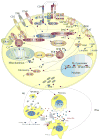Oxidative stress and endosome recycling are complementary mechanisms reorganizing the T-cell receptor signaling complex in SLE
- PMID: 22245265
- PMCID: PMC4048946
- DOI: 10.1016/j.clim.2011.12.011
Oxidative stress and endosome recycling are complementary mechanisms reorganizing the T-cell receptor signaling complex in SLE
Figures

Comment on
-
Linker for activation of T cells is displaced from lipid rafts and decreases in lupus T cells after activation via the TCR/CD3 pathway.Clin Immunol. 2012 Mar;142(3):243-51. doi: 10.1016/j.clim.2011.12.010. Epub 2011 Dec 30. Clin Immunol. 2012. PMID: 22285373
Similar articles
-
Linker for activation of T cells is displaced from lipid rafts and decreases in lupus T cells after activation via the TCR/CD3 pathway.Clin Immunol. 2012 Mar;142(3):243-51. doi: 10.1016/j.clim.2011.12.010. Epub 2011 Dec 30. Clin Immunol. 2012. PMID: 22285373
-
TCR zeta-chain abnormalities in human systemic lupus erythematosus.Methods Mol Med. 2004;102:49-72. doi: 10.1385/1-59259-805-6:049. Methods Mol Med. 2004. PMID: 15286380
-
Altered T and B lymphocyte signaling pathways in lupus.Autoimmun Rev. 2009 Jan;8(3):179-83. doi: 10.1016/j.autrev.2008.07.040. Epub 2008 Aug 20. Autoimmun Rev. 2009. PMID: 18721908 Review.
-
Methods and protocols to study T cell signaling abnormalities in human systemic lupus erythematosus.Methods Mol Biol. 2012;900:25-60. doi: 10.1007/978-1-60761-720-4_3. Methods Mol Biol. 2012. PMID: 22933064
-
Altered signaling triggered by ligation of the TCR/CD3 receptor in T lymphocytes from patients with systemic lupus erythematosus: the road from anergy to autoimmunity.Int Rev Immunol. 2004 May-Aug;23(3-4):265-72. doi: 10.1080/08830180490452594. Int Rev Immunol. 2004. PMID: 15204088 Review.
Cited by
-
Exploring the molecular mechanism of Tripterygium Wilfordii Hook F in treating systemic lupus erythematosus via network pharmacology and molecular docking.Clin Rheumatol. 2025 Apr;44(4):1549-1569. doi: 10.1007/s10067-025-07311-4. Epub 2025 Feb 11. Clin Rheumatol. 2025. PMID: 39934490
-
Therapeutic potential and pharmacological insights of total glucosides of paeony in dermatologic diseases: a comprehensive review.Front Pharmacol. 2025 Jan 2;15:1423717. doi: 10.3389/fphar.2024.1423717. eCollection 2024. Front Pharmacol. 2025. PMID: 39822741 Free PMC article. Review.
-
Endosome Traffic Modulates Pro-Inflammatory Signal Transduction in CD4+ T Cells-Implications for the Pathogenesis of Systemic Lupus Erythematosus.Int J Mol Sci. 2023 Jun 28;24(13):10749. doi: 10.3390/ijms241310749. Int J Mol Sci. 2023. PMID: 37445926 Free PMC article. Review.
-
Metabolic control of the epigenome in systemic Lupus erythematosus.Autoimmunity. 2014 Jun;47(4):256-64. doi: 10.3109/08916934.2013.834495. Epub 2013 Oct 16. Autoimmunity. 2014. PMID: 24128087 Free PMC article. Review.
References
-
- Nambiar MP, Fisher CU, Warke VG, et al. Reconstitution of deficient T cell receptor zeta chain restores T cell signaling and augments T cell receptor/CD3-induced interleukin-2 production in patients with systemic lupus erythematosus. Arthritis Rheum. 2003;48:1948–1955. - PubMed
-
- Kyttaris VC, Krishnan S, Tsokos GC. Systems biology in systemic lupus erythematosus: Integrating genes, biology and immune function. Autoimmunity. 2006;39(8):705–709. - PubMed
Publication types
MeSH terms
Grants and funding
LinkOut - more resources
Full Text Sources
Medical

